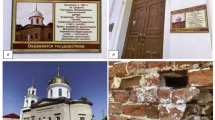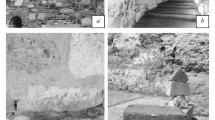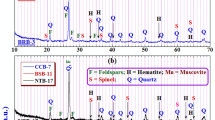Research has shown that mullite in brick from the Kazan kremlin crystallizes in the form of primary (‘flaky’) mullite, pseudomorphs of glass with needle-shaped mullite in terms of feldspar, and pseudomorphs of glass with short-prismatic mullite. Mössbauer absorption spectra showed that in the brick studied mainly hematite was found on the surface and magnetite in the interior volume.





Similar content being viewed by others
References
V. Z. Abdrakhimov and E. S. Abdrakhimova, “Phase composition of ceramic brick from the kremlin in Astrakhan,” Steklo Keram., No. 3, 33 – 40 (2014); V. Z. Abdrakhimov and E. S. Abdrakhimova, “Phase composition of ceramic brick from the kremlin in Astrakhan,” Glass Ceram., 71(3 – 4), 105 – 108 (2014).
V. Z. Abdrakhimov, “Relation between the phase composition and durability of ceramic brick older than 600 yr at the Ipat’-evskii monastery,” Steklo Keram., No. 3, 29 – 32 (2013); V. Z. Abdrakhimov, “Relation between the phase composition and durability of ceramic brick older than 600 yr at the Ipat’- evskii monastery,” Glass Ceram., 70(3 – 4), 100 – 103 (2013).
V. Z. Abdrakhimov, “Effect of the phase composition on the durability of ceramic facing of the Shakhi-Zinda ensemble in Samarkand,” Steklo Keram., No. 3, 38 – 40 (2012); V. Z. Abdrakhimov, “Effect of the phase composition on the durability of ceramic facing of the Shakhi-Zinda ensemble in Samarkand,” Glass Ceram., 69(3 – 4), 104 – 106 (2012).
E. S. Abdrakhimova and V. Z. Abdrakhimov, “Structural transformations of iron compounds into clay materials according to Mössbauer spectroscopy,” Zh. Fiz. Khim. Ross. Akad. Nauk, 80(7), 1227 – 1232 (2006).
E. S. Abdrakhimova and V. Z. Abdrakhimov, “Transformations of iron oxides during firing of beidellite clay,” Zh. Neorg. Khim. Ross. Akad. Nauk, 54(1), 42 – 46 (2009).
G. V. Kukolev, Silicon Chemistry and Silicate Physical Chemistry [in Russian], Vyssh. Shk., Moscow (1966).
A. A. Pashchenko, A. A. Myasnikov, U. A. Myasnikova, et al., Physical Chemistry of Silicates [in Russian], Vyssh. Shk., Moscow (1986).
V. F. Pavlov, Physical-Chemical Principles of Firing of Building Ceramic Articles [in Russian], Stroiizdat, Moscow (1986).
G. I. Litvinova and G. I. Pirozhkova, Petrography of Nonmetallic Inclusions [in Russian], Metallurgiya, Moscow (1972).
V. F. Pavlov, I. M. Meshcheryakova, and O. S. Grum-Grzhimailo, “Role of iron oxide in the formation of the structure of acid-resistant porcelain,” in: Proc. of the Scientific-Research Institute of Building Ceramics: Scientific Research in the Field of Mechanization of Technological Processes and Development of Paste Compositions and Glazes [in Russian], Moscow (1982), pp. 48 – 56.
A. S. Sadunas and V. M. Vasilyaukas, “On the question of the effect of FeO on the formation of mullite from kaolin,” in: Proc. of the VNIIteploizolyatsiya Institute [in Russian], Vil’nyus (1970), Issue 4, pp. 226 – 236.
E. S. Abdrakhimova and V. Z. Abdrakhimov, “Synthesis of mullite from technogenic raw material and pyrophyllite,” Zh. Neorg. Khim. Ross. Akad. Nauk, 52(3), 395 – 400 (2007).
Author information
Authors and Affiliations
Corresponding author
Additional information
Translated from Steklo i Keramika, No. 2, pp. 34 – 38, February, 2015.
Rights and permissions
About this article
Cite this article
Abdrakhimov, V.Z., Abdrakhimova, E.S. Interrelation of the Phase Composition and Durability of More than 800 Year Old Brick for the Example of the Kazan Kremlin. Glass Ceram 72, 71–75 (2015). https://doi.org/10.1007/s10717-015-9727-1
Published:
Issue Date:
DOI: https://doi.org/10.1007/s10717-015-9727-1




